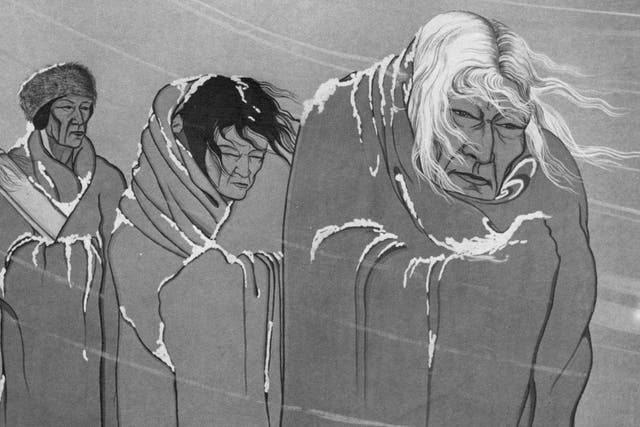

At the beginning of the 1830s, nearly 125,000 Native Americans lived on millions of acres of land in Georgia, Tennessee, Alabama, North Carolina and Florida–land their ancestors had occupied and cultivated for generations. But by the end of the decade, very few natives remained anywhere in the southeastern United States. Working on behalf of white settlers who wanted to grow cotton on the Indians’ land, the federal government forced them to leave their homelands and walk hundreds of miles to a specially designated “Indian Territory” across the Mississippi River. This difficult and oftentimes deadly journey is known as the Trail of Tears.
White Americans, particularly those who lived on the western frontier, often feared and resented the Native Americans they encountered: To them, American Indians seemed to be an unfamiliar, alien people who occupied land that white settlers wanted (and believed they deserved).
Some officials in the early years of the American republic, such as President George Washington, believed that the best way to solve this “Indian problem” was to simply “civilize” the Native Americans. The goal of this civilization campaign was to make Native Americans as much like white Americans as possible by encouraging them convert to Christianity, learn to speak and read English and adopt European-style economic practices such as the individual ownership of land and other property (including, in some instances in the South, enslaved persons).
In the southeastern United States, many Choctaw, Chickasaw, Seminole, Creek and Cherokee people adopted these customs and became known as the “Five Civilized Tribes.”
Severe exposure, starvation and disease ravaged tribes during their forced migration to present‑day Oklahoma.
Check out seven facts about this infamous chapter in American history.
The conflict was their last, best chance for outside military help to protect their homelands from westward expansion.
The Cherokee people were divided: What was the best way to handle the government’s determination to get its hands on their territory? Some wanted to stay and fight. Others thought it was more pragmatic to agree to leave in exchange for money and other concessions.
In 1835, a few self-appointed representatives of the Cherokee nation negotiated the Treaty of New Echota, which traded all Cherokee land east of the Mississippi — roughly 7 million acres — for $5 million, relocation assistance and compensation for lost property.
To the federal government, the treaty (signed in New Echota, Georgia) was a done deal, but a majority of the Cherokee felt betrayed. Importantly, the negotiators did not represent the tribal government or anyone else. Most Cherokee people considered the Treaty of New Echota fraudulent, and the Cherokee National Council voted in 1836 to reject it.
“The instrument in question is not the act of our nation,” wrote the nation’s principal chief, John Ross, in a letter to the U.S. Senate protesting the Treaty of New Echota. “We are not parties to its covenants; it has not received the sanction of our people.” Nearly 16,000 Cherokees signed Ross’s petition, but Congress approved the treaty anyway.
By 1838, only about 2,000 Cherokees had left their Georgia homeland for Indian Territory. President Martin Van Buren sent General Winfield Scott and 7,000 soldiers to expedite the removal process. Scott and his troops forced the Cherokee into stockades at bayonet point while his men looted their homes and belongings.
Then, they marched the Indians more than 1,200 miles to Indian Territory. Whooping cough, typhus, dysentery, cholera and starvation were epidemic along the way. Historians estimate that more than 5,000 Cherokee died as a result of the journey.
By 1840, tens of thousands of Native Americans had been driven off of their land in the southeastern states and forced to move across the Mississippi to Indian Territory. The federal government promised that their new land would remain unmolested forever, but as the line of white settlement pushed westward, “Indian Country” shrank and shrank. In 1907, Oklahoma became a state and Indian Territory was considered lost.
A 2020 decision by the Supreme Court, however, highlighted ongoing interest in Native American territorial rights. In a 5-4 decision, the Court ruled that a huge area of Oklahoma is still considered an American Indian reservation.
This decision left the state of Oklahoma unable to prosecute Native Americans accused of crimes on those tribal lands — only federal and tribal law enforcement can prosecute such crimes. (A later 2022 Supreme Court decision rolled back some provisions of the 2020 court finding.)
The Trail of Tears — actually a network of different routes — is over 5,000 miles long and covers nine states: Alabama, Arkansas, Georgia, Illinois, Kentucky, Missouri, North Carolina, Oklahoma and Tennessee. Today, the Trail of Tears National Historic Trail is run by the National Park Service and portions of it are accessible on foot, by horse, by bicycle or by car.
Trail of Tears. NPS.gov.
Trail of Tears. Museum of the Cherokee Indian.
The Treaty of New Echota and the Trail of Tears. North Carolina Department of Natural and Cultural Resources.
The Treaty That Forced the Cherokee People from Their Homelands Goes on View. Smithsonian Magazine.
Justices rule swath of Oklahoma remains tribal reservation. Associated Press.
Justices limit 2020 ruling on tribal lands in Oklahoma. Associated Press.
From Comanche warriors to Navajo code talkers, learn more about Indigenous history.